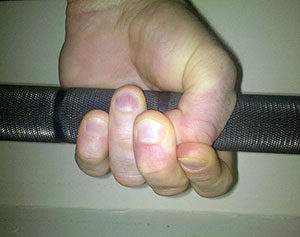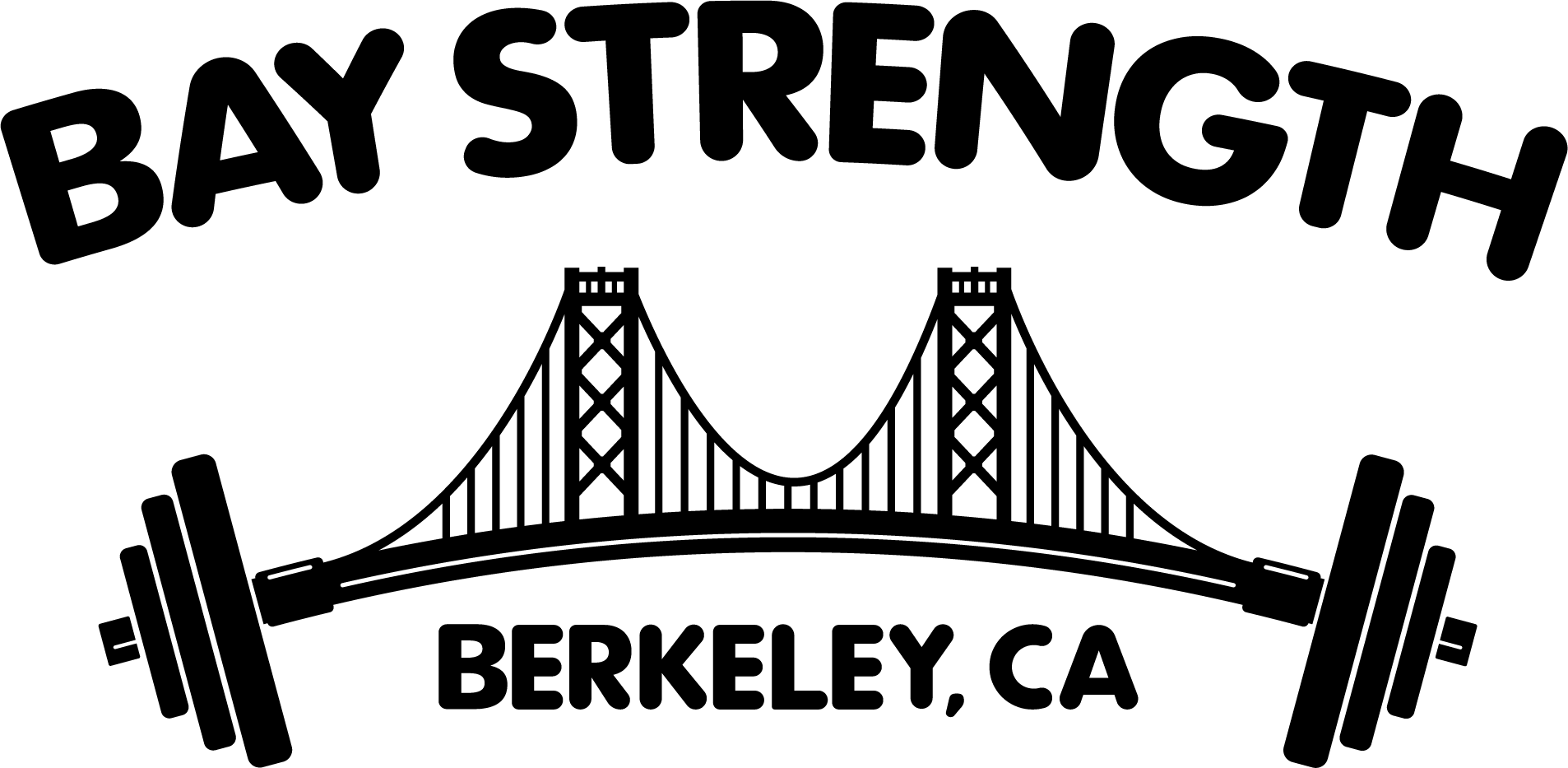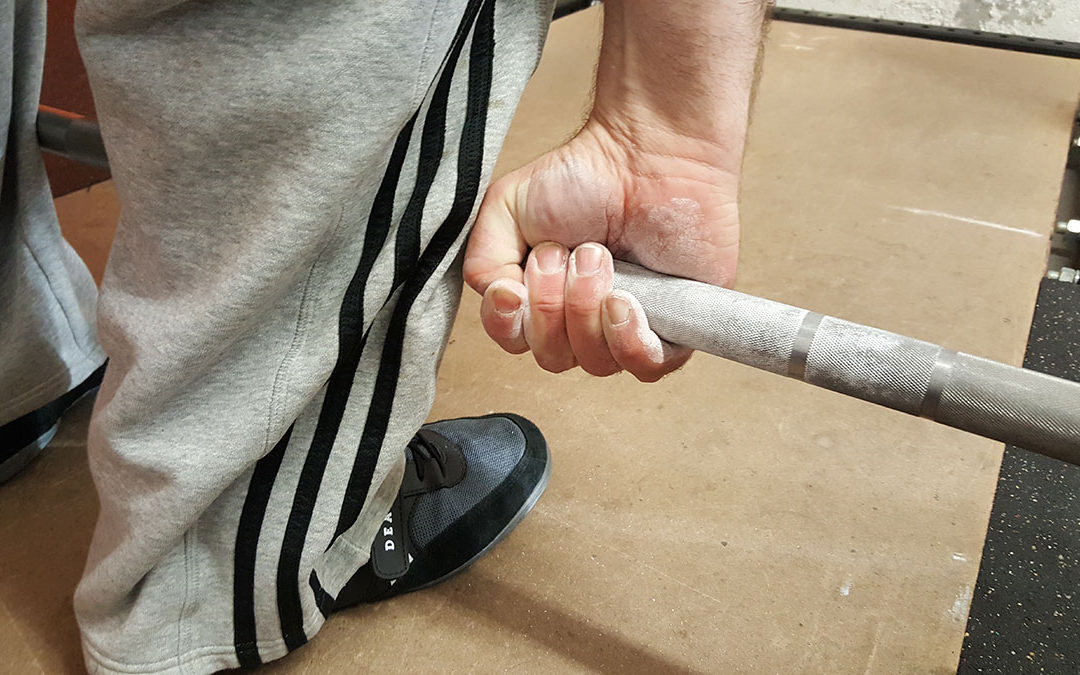Selection of grip is an important consideration for the deadlift. In the Starting Strength method, we start new lifters with a double overhand grip because it produces a symmetrical stress across the shoulders and because it builds grip strength.
But before long, every lifter reaches a point where the weight on the bar in the deadlift exceeds their ability to hold onto the bar with a double overhand grip. When this happens, they need to switch to either a mixed grip or a hook grip.
The mixed grip is by far the more common of the two. In the mixed grip, one hand is pronated (palm down) while the other, usually the non-dextrous hand, is supinated (palm up). The mixed grip solves the problem of the bar rolling out of the fingers in a double overhand grip, and it is so commonly used in deadlifting that some people think of it as the default deadlift grip.
But there are some significant downsides to the mixed grip. One is that it places an uneven stress on the shoulders. Two, the mixed grip will tend to make the bar swing away from the lifter’s legs on the supinated side. Finally, there is a small but non-negligible risk of a biceps tendon avulsion when using a mixed grip.

The hook grip. Learn it, love it, use it.
While there are ways to address the latter two issues with the mixed grip, a better option is to use a different grip entirely: the hook grip.
In the hook grip, both hands are pronated, but the thumb, instead of wrapping on top of the fingers, tucks underneath the middle and index fingers, directly against the bar. The additional friction of the thumb against the bar makes the hook grip a stronger grip than the double overhand grip. Because both hands are pronated in the hook grip, the stresses on the shoulders are symmetrical, the risk of a biceps tendon avulsion is greatly reduced, and it is easier to keep the bar on the legs.
For these reasons, I encourage all my lifters to train their deadlift with a hook grip when the weight becomes heavy enough that they can no longer pull with a double overhand grip. This may not be a viable option for some lifters, such as individuals with very small hands. But most people can successfully use the hook grip to deadlift their work weights, provided they can push themselves past the early discomfort of the grip when they first learn it.
How to introduce the hook grip into your training
The challenge that most lifters experience with the hook grip is that it is uncomfortable — at least at the beginning. Most new lifters do not enjoy the sensation of their thumb being pinched against the rough knurling of the barbell. But, with practice, it is possible to quickly acclimate to using the hook grip at your heaviest deadlift weights. Here are my suggestions for how to go about the process.
Start by training the hook grip on your warmup sets of the deadlift. Use it through the heaviest warmup sets that you can manage. Whatever you can manage on your first day is fine. It will be uncomfortable. Suck it up and push through. When you cannot stand the discomfort any longer, switch to a mixed grip (for now) to complete your warmups and work set.
The next time you deadlift, repeat the process, but this time go further. Let’s say the first time you could use the hook grip for your first two warmup sets but not your third. This time, push yourself to use it for at least one rep of the third warmup set — or, even better, the entire thing. Do this at your next workout too, if necessary. Again, use the mixed grip (for now) for your work set if you must.
Hopefully after a few workouts of doing this, you are now ready to start using the hook grip on at least part of your work set. Set your grip as hard as you can, and resolve to pull at least the first rep of your work set with a hook grip, no matter how uncomfortable it feels. Switch to the mixed grip for the rest of the set if you have to.
From here on out, resolve that each workout you’re going to hook grip at least one more rep of your work set. If you can do more, great! Within a few more workouts you should now be using the hook grip for the entirety of your work set.
At this point, the hook grip may still be uncomfortable during your work set, but you have now built up the toughness to use it at your work weight, so you should continue doing so from here on out. Eventually, the hook grip will become an afterthought as you become desensitized to the pinching sensation.
Once you’re using the hook grip for your work set, you can revert to using the double overhand grip through as many of your warmups as it will permit. You still want to use it with as heavy a weight as you can so that you are training your grip strength.
A word on chalk
For many lifters this will go without saying, but: when you are performing any of the barbell lifts, but especially when you are pulling, you should be thoroughly chalking your hands. Chalk will help dry out your hands and lead to a more secure grip on the bar, regardless of which grip you are using.
For more, watch the below video of Rip discussing the benefits of the hook grip:


I tried out hookgrip seriously in one of my last workouts… I have to say, I’m considering transitioning to it after the meet! Definitely kills my thumbs though!
Yeah it hurts at first but eventually it’s just part of the general discomfort of the deadlift. Helps me get psyched up actually. You can do it!
What do You thick
About 5/5 programme
String lift?
I think 5×5 is excessive volume if you are a novice. Once you’re done with a linear progression, you need to increase volume, and 5×5 is the way to go on the big lifts.
Yup best grip out there hook…mix grip bad leads to muscle imbalance
can these be done on max effort attempts? in the ranges of 600lbs?
Here’s Mark Wood pulling 792 lbs for a double with a hook grip, so yes: https://barbend.com/mark-wood-deadlifts-792-pounds-double-hook-grip/
Thanks for a very helpful page. A few things helped me deadlift for a PR yesterday after just three or four sessions practicing hook grip:
1. Before you close your grip, bend your thumbs so that they point along the axis of the barbell. Clint Darden’s video on YouTube is helpful here.
2. Grab the bar up in the crook of your thumb, rather than low in your fingers like an overhand grip. This makes it easier to reach your fingers over your thumbs.
3. Before you prepare to pull, lock your grip by giving a little tug. Stop giggling.
4. For the first few sessions, use hook grip on every pull until you gain confidence; after that, use it only when overhand grip won’t get you through the set.